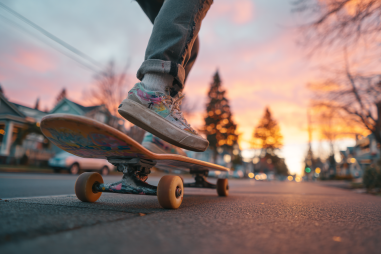Skateboarding is not just about balance and style; it’s about moving your body in ways that demand both flexibility and mobility. These two components are crucial for executing smooth tricks, maintaining control, and preventing injuries. If you’ve noticed tightness in your hips, knees, or ankles, or if you find some tricks harder to pull off due to limited movement, it might be time to incorporate specific flexibility and mobility training into your routine. This guide will walk you through why these elements matter and introduce you to effective drills and stretches tailored for skateboarders like you.
Why Flexibility and Mobility Are Essential in Skateboarding
Flexibility refers to the ability of your muscles and tendons to lengthen, while mobility is about the range of motion available at your joints. In skateboarding, both are vital. Great flexibility allows you to bend and stretch without strain, while mobility ensures your joints can move freely through all necessary angles. Together, they help you absorb impacts, maintain stability over uneven surfaces, and perform tricks that require fluid motion.
Without adequate flexibility and mobility, skaters are more prone to muscle tightness and joint stiffness. This can lead to a stiff, robotic style of skating that not only looks less graceful but also increases the risk of injuries such as sprained ankles, knee pain, or hip discomfort. On the other hand, a body with good flexibility and mobility helps you react naturally and smoothly, rolling with stresses instead of buckling under them.
Common Tight Areas for Skateboarders
Skateboarding typically involves repeated flexion and twisting movements, which can cause certain muscle groups and joints to become tight over time. The most common areas that skateboarders find tight include:
- Hips: Tight hip flexors and glutes are common due to constant squatting and shifting weight.
- Knees: Although the knee itself doesn’t have a broad range of motion like a ball-and-socket joint, the muscles around it — such as the quadriceps and hamstrings — can become stiff and limit movement.
- Ankles: Ankles require good dorsiflexion and plantarflexion to absorb shocks and control board movements. Tightness in the calf muscles and Achilles tendon can restrict this essential range.
Recognizing these key tight areas helps you target your flexibility and mobility training effectively, ensuring optimal performance on your board.
Dynamic vs. Static Stretching: What’s the Difference?
Understanding the types of stretching is crucial to get the best results from your routine. Both dynamic and static stretching serve different purposes:
- Dynamic Stretching: This involves active movements that take your muscles and joints through their full range of motion. Examples include leg swings, hip circles, and ankle rolls. Dynamic stretches are ideal as a warm-up method because they increase blood flow and prepare your body for the demands of skating.
- Static Stretching: Static stretches involve holding a muscle in a stretched position for 20-30 seconds or longer. Think of hamstring stretches or seated forward folds. These are best performed post-skate to enhance muscle length and flexibility and help prevent soreness.
Incorporating both types properly into your routine ensures your muscles are warmed up before skating and given adequate recovery afterward.
Mobility Drills for Hips, Knees, and Ankles
Improving joint mobility can transform your skating by enhancing the fluidity and range of your movements. Here are some effective mobility drills to target your key joints:
Hips
- Hip Circles: Stand on one leg, lift the opposite knee towards your chest, then rotate your lifted leg in circular motions. This improves the range in the hip joint.
- 90/90 Stretch: Sit on the floor with one leg bent at a 90-degree angle in front and the other leg bent behind you also at 90 degrees. Gently lean forward over the front leg to stretch your hip muscles and improve rotational mobility.
Knees
- Knee Bends: Perform slow, controlled knee bends (mini-squats), ensuring knees track over toes without collapsing inward. This keeps the knee joint healthy and reinforces proper movement patterns.
- Leg Swings: Front-to-back and side-to-side leg swings loosen the muscles around the knee and prepare them for dynamic use.
Ankles
- Ankle Circles: Seated or standing, lift one foot off the ground and rotate your foot clockwise and counterclockwise.
- Calf Raises: Slowly rise up onto your toes and then lower down. This strengthens and mobilizes the ankle complex.
Stretching Routines Before and After Skate Sessions
Knowing when and how to stretch can make a big difference in your skating quality and recovery. Here’s how you can structure your stretching:
Before Skateboarding
Focus on dynamic stretching to actively warm your muscles and joints. Try leg swings, hip openers, and ankle rolls for 5-10 minutes to build mobility and prepare your body for skating intensity.
After Skateboarding
Once your session is over, switch to static stretching to lengthen muscles and promote recovery. Spend 10-15 minutes performing stretches such as seated forward folds for your hamstrings, lunges for your hip flexors, and calf stretches to release ankle tension.
Incorporating Yoga and Other Flexibility Exercises
Yoga is a fantastic complement to skateboarding because it combines strength, balance, and flexibility training with breath control. Poses like Pigeon Pose, Downward Dog, and Warrior sequences specifically target the hips, knees, and ankles, helping maintain joint health and muscle flexibility. Additionally, Pilates and mobility-focused workouts can add variety to your routine and address imbalances.
By committing to yoga or similar practices even once or twice a week, you’ll likely notice improved balance, reduced stiffness, and a greater ability to hold skateboarding stances and execute tricks fluidly.
Tips to Improve Range of Motion Consistently
Consistency is key when it comes to enhancing flexibility and mobility. Here are some tips to help you stay on track:
- Make it a Daily Habit: Even just 10 minutes of mobility drills or stretching daily can yield fantastic results over time.
- Listen to Your Body: Never force a stretch deeply enough to cause sharp pain; stretch gently to avoid injury.
- Use Props: Yoga blocks, straps, or resistance bands can help deepen stretches safely.
- Warm Up Before Stretching: Mild movement or heat beforehand helps muscles stretch more effectively.
- Track Your Progress: Keep a journal or use apps to note improvements in flexibility or how your body feels on the board.
Improving your flexibility and mobility won’t happen overnight, but with persistence, you’ll unlock new levels of control, reduce injury risks, and make your skate sessions more enjoyable.
Skate Smoothly and Safely with Flexibility Training
By embracing flexibility and mobility exercises as part of your skateboarding routine, you’re giving yourself a valuable edge. These elements let your muscles and joints work together fluidly, helping you approach each trick with confidence and style while staying healthy. Whether you’re honing your ollies or mastering flip tricks, a body that moves well is a body that rides pain-free. Start incorporating dynamic warm-ups, targeted mobility drills, and relaxing post-session stretches today and feel the difference in your skating performance and overall enjoyment.







